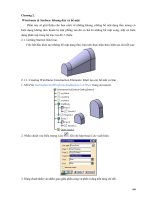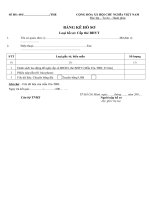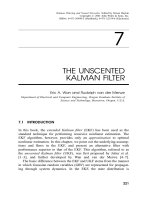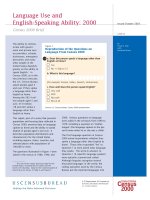Tài liệu Clinical Physiology and Pharmacology The Essentials ppt
Bạn đang xem bản rút gọn của tài liệu. Xem và tải ngay bản đầy đủ của tài liệu tại đây (3.63 MB, 338 trang )
Clinical Physiology
and Pharmacology
The Essentials
Farideh Javid
Division of Pharmacy and Pharmaceutical Sciences,
School of Applied Sciences, University of Huddersfield, UK
and
Janice McCurrie
School of Pharmacy, University of Bradford, UK
A John Wiley & Sons, Ltd., Publication
Clinical Physiology
and Pharmacology
Clinical Physiology
and Pharmacology
The Essentials
Farideh Javid
Division of Pharmacy and Pharmaceutical Sciences,
School of Applied Sciences, University of Huddersfield, UK
and
Janice McCurrie
School of Pharmacy, University of Bradford, UK
A John Wiley & Sons, Ltd., Publication
This edition first published 2008
2008 by John Wiley & Sons, Ltd
Wiley-Blackwell is an imprint of John Wiley & Sons, formed by the merger of Wiley’s global
Scientific, Technical and Medical business with Blackwell Publishing.
Registered office: John Wiley & Sons Ltd, The Atrium, Southern Gate, Chichester,
West Sussex, PO19 8SQ, UK
Other Editorial Offices:
9600 Garsington Road, Oxford, OX4 2DQ, UK
111 River Street, Hoboken, NJ 07030-5774, USA
For details of our global editorial offices, for customer services and for information about
how to apply for permission to reuse the copyright material in this book please see our
website at www.wiley.com/wiley-blackwell
Therightoftheauthortobeidentifiedastheauthorofthisworkhasbeenassertedin
accordance with the Copyright, Designs and Patents Act 1988.
All rights reserved. No part of this publication may be reproduced, stored in a retrieval
system, or transmitted, in any form or by any means, electronic, mechanical, photocopying,
recording or otherwise, except as permitted by the UK Copyright, Designs and Patents Act
1988, without the prior permission of the publisher.
Wiley also publishes its books in a variety of electronic formats. Some content that appears
in print may not be available in electronic books.
Designations used by companies to distinguish their products are often claimed as
trademarks. All brand names and product names used in this book are trade names, service
marks, trademarks or registered trademarks of their respective owners. The publisher is not
associated with any product or vendor mentioned in this book. This publication is designed
to provide accurate and authoritative information in regard to the subject matter covered. It
is sold on the understanding that the publisher is not engaged in rendering professional
services. If professional advice or other expert assistance is required, the services of a
competent professional should be sought.
ISBN 978-0-470-51852-6 (HB) 978-0-470-51853-3 (PB)
A catalogue record for this book is available from the British Library.
Typeset in 10.5/12.5 Minion by Laserwords Private Limited, Chennai, India
Printed and bound in Singapore by Markono Pte. Ltd
First printing 2008
Contents
Preface xi
CASE STUDIES 1
1 Psychological disorders 3
CASE STUDY 1 A mother’s loss 3
CASE STUDY 2 A dangerous father? 6
CASE STUDY 3 Continual concerns for Mr Watson 8
CASE STUDY 4 A scary presentation 9
CASE STUDY 5 Fussy Jane 11
CASE STUDY 6 David’s withdrawal 12
CASE STUDY 7 Forgetful mum 14
CASE STUDY 8 Disruptive John 15
2 Neurological disorders 17
CASE STUDY 9 Mrs Smith’s tremor 17
CASE STUDY 10 Rose’s loss of consciousness 19
CASE STUDY 11 Another day away from the office 21
CASE STUDY 12 Drooping eyelids 22
3 Endocrine disorders 25
CASE STUDY 13 An agitated mother 25
CASE STUDY 14 A vague and sleepy lady 27
CASE STUDY 15 A dehydrated businesswoman 29
CASE STUDY 16 Brian’s weight gain 31
CASE STUDY 17 The thirsty schoolboy 33
CASE STUDY 18 Eric’s expanding waistline 35
vi CONTENTS
4 Cardiovascular disorders 37
CASE STUDY 19 Annie’s heartache 37
CASE STUDY 20 The executive’s medical check-up 39
CASE STUDY 21 A hypertensive emergency 42
CASE STUDY 22 Harry Mann’s bad day 45
CASE STUDY 23 Grandpa’s silence 47
CASE STUDY 24 The gardener who collapsed on his lawn 49
CASE STUDY 25 Hanna’s palpitations 51
5 Respiratory disorders 53
CASE STUDY 26 Moving to England 53
CASE STUDY 27 The sneezing boy 55
CASE STUDY 28 Mandy’s sleepover 56
CASE STUDY 29 Bob and Bill’s breathing problems 58
CASE STUDY 30 A punctured chest 60
CASE STUDY 31 Carmen’s repeated respiratory infections 62
CASE STUDY 32 Chandra’s chronic bronchitis 64
6 Kidney and body fluid disorders 67
CASE STUDY 33 Greg’s glomerulonephritis 67
CASE STUDY 34 Kevin’s chronic kidney problems 69
CASE STUDY 35 The polar bear’s fun run 71
CASE STUDY 36 The housewife who drank too much 73
7 Blood disorders 75
CASE STUDY 37 An exhausted mother 75
CASE STUDY 38 Patsy’s Australian journey 78
CASE STUDY 39 The dizzy blonde 80
8 Gastrointestinal disorders 83
CASE STUDY 40 Mr Benjamin’s bowel problem 83
CASE STUDY 41 A disturbed holiday 85
CASE STUDY 42 Jude’s sudden admission to hospital 86
CASE STUDY 43 The producer’s stomach ache 88
CASE STUDY 44 Daria’s abdominal pain 90
CASE STUDY 45 That bloated feeling 92
CONTENTS vii
9 Autonomic disorders 95
CASE STUDY 46 Rob’s ocular accident 95
CASE STUDY 47 A severe attack of greenfly 97
10 Reproductive disorders 99
CASE STUDY 48 Panic of a college girl 99
CASE STUDY 49 Shabana’s monthly problems 101
CASE STUDY 50 Demi’s baby 103
ANSWERS 105
1 Psychological disorders 107
CASE STUDY 1 A mother’s loss 107
CASE STUDY 2 A dangerous father? 111
CASE STUDY 3 Continual concerns for Mr Watson 114
CASE STUDY 4 A scary presentation 116
CASE STUDY 5 Fussy Jane 119
CASE STUDY 6 David’s withdrawal 121
CASE STUDY 7 Forgetful mum 124
CASE STUDY 8 Disruptive John 126
2 Neurological disorders 129
CASE STUDY 9 Mrs Smith’s tremor 129
CASE STUDY 10 Rose’s loss of consciousness 133
CASE STUDY 11 Another day away from the office 136
CASE STUDY 12 Drooping eyelids 139
3 Endocrine disorders 143
CASE STUDY 13 An agitated mother 143
CASE STUDY 14 A vague and sleepy lady 146
CASE STUDY 15 A dehydrated business woman 149
CASE STUDY 16 Brian’s weight gain 153
CASE STUDY 17 The thirsty schoolboy 158
CASE STUDY 18 Eric’s expanding waistline 163
4 Cardiovascular disorders 169
CASE STUDY 19 Annie’s heartache 169
viii CONTENTS
CASE STUDY 20 The executive’s medical check-up 174
CASE STUDY 21 A hypertensive emergency 179
CASE STUDY 22 Harry Mann’s bad day 183
CASE STUDY 23 Grandpa’s silence 187
CASE STUDY 24 The gardener who collapsed on his lawn 191
CASE STUDY 25 Hanna’s palpitations 196
5 Respiratory disorders 201
CASE STUDY 26 Moving to England 201
CASE STUDY 27 The sneezing boy 204
CASE STUDY 28 Mandy’s sleepover 206
CASE STUDY 29 Bob and Bill’s breathing problems 210
CASE STUDY 30 A punctured chest 213
CASE STUDY 31 Carmen’s repeated respiratory infections 217
CASE STUDY 32 Chandra’s chronic bronchitis 221
6 Kidney and body fluid disorders 227
CASE STUDY 33 Greg’s glomerulonephritis 227
CASE STUDY 34 Kevin’s chronic kidney problems 233
CASE STUDY 35 The polar bear’s fun run 238
CASE STUDY 36 The housewife who drank too much 245
7 Blood disorders 249
CASE STUDY 37 An exhausted mother 249
CASE STUDY 38 Patsy’s Australian journey 254
CASE STUDY 39 The dizzy blonde 259
8 Gastrointestinal disorders 263
CASE STUDY 40 Mr Benjamin’s bowel problem 263
CASE STUDY 41 A disturbed holiday 266
CASE STUDY 42 Jude’s sudden admission to the hospital 269
CASE STUDY 43 The producer’s stomach ache 273
CASE STUDY 44 Daria’s abdominal pain 278
CASE STUDY 45 That bloated feeling 283
9 Autonomic disorders 289
CASE STUDY 46 Rob’s ocular accident 289
CASE STUDY 47 A severe attack of greenfly 293
CONTENTS ix
10 Reproductive disorders 299
CASE STUDY 48 Panic of a college girl 299
CASE STUDY 49 Shabana’s monthly problems 304
CASE STUDY 50 Demi’s baby 311
Glossary 319
Index 337
Introduction
Physiology plays a major role in the scientific foundation of medicine and other
subjects related to human health and physical performance. Pharmacology is the
science which deals with the effects of drugs on living systems and their use in the
treatment of disease. This book is designed to enhance students’ understanding of
physiology and pharmacology via a series of case studies involving human disease
and its treatment.
Traditional university teaching methods focus on informing students in terms of
physiological and pharmacological theory. This approach, although often extremely
efficient and effective, may leave students in a position of remembering the facts
and understanding the mechanisms but not necessarily being able to apply their
knowledge to real-life situations. The latter ability is a skill which requires time and
experience to develop and its acquisition is a key goal in vocational programmes,
such as those associated with the training of doctors, pharmacists and other health
care professionals. In our own teaching we have found that one very effective
means of acquiring this all-important skill is via the use of clinical case studies. The
case studies bring basic physiology and pharmacology to life, allowing students to
examine ways in which the disruption of homeostatic mechanisms results in patients
presenting with specific signs and symptoms. Case studies also enable students to
understand how these signs and symptoms can facilitate diagnosis, and this is
augmented as the students gain understanding of ways in which pharmacological
intervention can be used to treat disruptions in homeostasis.
This book consists of a series of chapters containing case studies organized by
major organ system; the book also contains answers to all the questions. There
are very few texts available that use clinically relevant case studies to facilitate a
student-centred learning approach. This book is designed to fill that niche. This
type of student-centred learning not only brings theoretical subjects to life but also
promotes deep learning, reflection and enhances analytical skills. We hope you
enjoy working through these cases and would be happy to receive your comments
on this book to inform future editions.
xii PREFACE
Aims of the Book
The case studies and the questions which follow will aid your understanding of
many types of biological and clinical factors. They are intended to help you prepare
for problems associated with clinical physiology and pharmacology that you may
meet both in formal examinations and in future professional practice. The case
studies presented cover a wide range of psychological, neurological, endocrine,
cardiovascular, respiratory, renal, gastrointestinal and reproductive disorders, their
symptoms, complications and usual treatment along with the actions, dosage and
uses of some widely used drugs. The key points for each case study, which can be
found in the Answers section will aid your revision of the major factors associated
with each disease or condition.
These case studies provide a practical illustration of common disease states,
together with their treatment; the explanations given will help you to relate these
conditions to knowledge gained from your lecture courses.
Learning Outcomes
After successfully completing each case, you should be able to:
• understand and describe the signs and symptoms of the disorder in question and
its underlying pathophysiology;
• understand and describe the pharmacology of agents currently used in the
treatment of the disorder studied;
• appreciate some of the key issues in determining appropriate medication;
• continue to develop your problem-solving skills.
Using This Book
Clinical Physiology and Pharmacology is written primarily for undergraduate stu-
dents studying modules in physiology and pharmacology as part of a degree in
science, pharmacy, preclinical medicine or other health-related courses.
One of the challenges in studying physiology and pharmacology is the very large
number of facts and ideas that must be remembered; this factual load can seem
daunting. To understand how drugs produce their therapeutic effect, it is essential
to have knowledge and understanding of both the physiological mechanisms which
underpin pharmacology and the mechanisms of action of drugs currently being
used. In addition the innovations of the pharmaceutical industry ensure that the
extensive list of therapeutic drugs to be considered continues to increase each
year.
Isolated facts, physiological mechanisms, drug names and actions can sometimes
be remembered for only a comparatively short time. However, this process of
memorizing and understanding facts represents only the first step in your learning.
PREFACE xiii
The next vital stage is to develop your ability to interpret, analyse and use this
information in order to solve problems and formulate solutions. Using what you
have remembered from your physiology and pharmacology studies to interpret
the cases presented in this book will help to move factual knowledge from your
superficial memory into deep-memory stores, illustrate the clinical application of
this basic knowledge, assist you in revising many important topics and improve
both your skills and confidence in problem-solving. Since the information is placed
in a realistic setting, your recall of key facts and concepts in physiology and
pharmacology will be enhanced.
We hope that using this book will also prove to be a useful step towards applying
these skills during your future professional life.
The Case Studies
The case studies are presented as short scenarios with interlinked questions that
will both challenge your understanding and lead you through the major learning
outcomes of the case as it unfolds.
The learning outcomes to be achieved are clearly stated at the beginning of
each case study and will focus your attention on the most important facts, topics,
mechanisms and concepts to be addressed as you work through it.
Although each case study presents a unique scenario, some important physio-
logical mechanisms and pharmacological agents are involved in more than one of
the scenarios. This will give you the opportunity to rehearse knowledge already
gained from a previous case study to answer a question directly and enable you to
revise any aspects that were not previously clear. The overlap between cases will also
help to emphasize that some signs and symptoms are common to several different
conditions and that care must be taken to consider all the factors presented before
formulating your answers or coming to a conclusion about the case study.
Key points are provided for each case and are intended both as a short summary
of the essential points and as a focus for revision. They can be used to preview or
review the case content. Important points should then be easier to remember in
the future, especially when, by association, you can recall them in an appropriate
clinical context.
The glossary collects simple definitions of the most important terms into a single
location for easy reference.
The index lists the number of the case in which the key terms, conditions and
drugs are discussed.
The drug doses stated in this book were checked at the time of writing but may
now have changed due to revision or updating of treatment regimes. Current dosage
recommendations are available in the up-to-date British National Formulary or any
other Formulary.
Farideh Javid
Janice McCurrie
CASE STUDIES
1
Psychological disorders
CASE STUDY 1 A mother’s loss
Learning outcomes
On completion of the following case study, you will be able to:
• describe the signs and symptoms associated with this disorder;
• describe the underlying pathophysiology of the disorder presented;
• outline pharmacological approaches to the management of the symptoms;
• explain how drugs may cause their clinical benefits and side effects;
• outline the mechanism of action of amitriptyline hydrochloride;
• explain the advantages of using SSRIs (selective serotonin re-uptake
inhibitors) compared to tricyclic antidepressants and MOIs (monoamine
oxidase inhibitors).
Clinical Physiology and Pharmacology Farideh Javid and Janice McCurrie
2008 John Wiley & Sons, Ltd
4 CH 1 PSYCHOLOGICAL DISORDERS
Part 1
It has been nearly five months since 45-year-old Mrs Ford lost her only son. He
was 12 years old and was killed in a car accident while playing with his friends. She
has been feeling very down since it happened and has an overall feeling of utter
hopelessness. She is unable to feel happiness, has difficulty sleeping and her appetite
is greatly reduced. Mrs Ford used to enjoy socializing with her friends; however,
now she has lost interest. She had been planning to redecorate the house, but since
the loss of her son she cannot be bothered. She does not want to cook and when
hungry does not feel like eating. She feels that life has no meaning without her son
and wishes to join him very soon. Fortunately, Mrs Ford’s sister visited her recently
and was so worried about her condition that she convinced her to see a doctor. After
visiting her family doctor, Mrs Ford was prescribed amitriptyline hydrochloride.
The doctor advised her to take this medication at night.
Q1 What is the likely diagnosis of Mrs Ford’s symptoms?
Q2 List the symptoms of depression.
Q3 Which of Mrs Ford’s symptoms are consistent with the profile of depression?
Q4 Comment on the pathophysiology of this condition.
Q5 What treatments are available for depression?
Q6 Name three categories of drug currently used to treat patients with depression
and comment on their mechanisms of action.
Q7 To which category of drug does amitriptyline hydrochloride belong?
Q8 What is the recommended adult dose for amitriptyline hydrochloride? Why
was Mrs Ford advised to take the medication at night?
Q9 What are the possible side effects associated with the use of amitriptyline
hydrochloride?
Part 2
A week later Mrs Ford made another appointment with the doctor, complaining
that the prescribed medication was not effective.
Q10 Can you suggest an explanation for the amitriptyline hydrochloride being
ineffective? Does Mrs Ford need a different medication?
CASE STUDY 1 A MOTHER’S LOSS 5
Part 3
Three weeks later Mrs Ford visited her doctor again. She reported that her mood
had improved and that she felt better than before; however, she complained about
having a dry mouth and blurred vision. An alternative drug was prescribed, which
proved to be more suitable for Mrs Ford.
Q11 Suggest an alternative drug which is likely to be more suitable for Mrs Ford.
Q12 Outline the advantages of using SSRIs compared to tricyclic antidepressants.
Your answer should include an example of an SSRI and its recommended daily
dose.
Q13 Name the main side effects associated with the use of SSRIs.
Q14 This patient was not prescribed an MOI. Comment on the disadvantages of
using MOIs in the treatment of depression.
6 CH 1 PSYCHOLOGICAL DISORDERS
CASE STUDY 2 A dangerous father?
Learning outcomes
On completion of the following case study, you will be able to:
• present an overview of mania, its aetiology and associated symptoms;
• outline a possible connection between the use of antidepressants and the
development of mania;
• explain therapeutic approaches to managing the symptoms;
• explain the limitations associated with the use of lithium.
Fifty-six-year-old Mr Watson was taken to his doctor by his daughter, who described
her dad’s condition as being critical and possibly dangerous. She explained that
her dad was extremely overexcitable, irritable and angry most of the time; he had
developed the delusion that he was in possession of special powers and was showing
inappropriate elation. She also mentioned that he had been taking antidepressants
for a while, following her mother’s death one year earlier.
The doctor made a diagnosis and prescribed lithium, advising Mr Watson
to stop taking his antidepressant medication and also not to take non-steroidal
anti-inflammatory drugs in combination with his new medication.
Q1 What is your diagnosis of Mr Watson’s condition?
Q2 What are the symptoms of mania?
Q3 Outline the underlying pathophysiology of mania.
Q4 Is there a relationship between the development of mania and the use of
antidepressants?
Q5 When lithium therapy is initiated, what is the recommended daily dose?
Q6 Describe the mechanism of action of lithium.
Q7 Comment on the side effects associated with the use of lithium.
CASE STUDY 2 A DANGEROUS FATHER? 7
Q8 Why was Mr Watson advised not to take non-steroidal anti-inflammatory
drugs in combination with lithium? Are any other medications contraindicated
for patients taking lithium?
Q9 Identify alternative drugs which can be used for patients with mania.
8 CH 1 PSYCHOLOGICAL DISORDERS
CASE STUDY 3 Continual concerns for Mr Watson
Learning outcomes
On completion of the following case study, you will be able to:
• present an overview of manic depressive disorder (bipolar affective disorder)
and the associated symptoms;
• describe its pathophysiology and pharmacological approaches to managing
the symptoms of manic depressive disorder;
• explain the clinical benefits and side effects of the drugs used.
Mr Watson has now been on medication to treat his mania for the past year.
Recently, his daughter consulted their doctor again, expressing concerns about her
father’s condition. She explained that her father is now experiencing two opposing
mood states: these range from depression to periods when he becomes agitated,
extremely talkative and does not want to go to sleep. His mood then appears elevated
and euphoric and these irritable moods can last for weeks. On further questioning
by the doctor, it became clear that her paternal grandfather had also suffered similar
mood swings.
Q1 What is the likely diagnosis for Mr Watson?
Q2 Comment on the pathophysiology of mood swings in manic depressive
disorder.
Q3 What is the recommended medication for patients with manic depressive
disorder?
Q4 What is the recommended dose of lithium for long-term therapy? Are any
special precautions necessary when patients are treated with this agent?
Q5 Name an alternative medication (including the daily dose) suitable to treat
manic depressive illness.
Q6 Is the fact that Mr Watson’s father also suffered from mood swings significant?
Q7 What advice should be given to patients with manic depressive illness?









